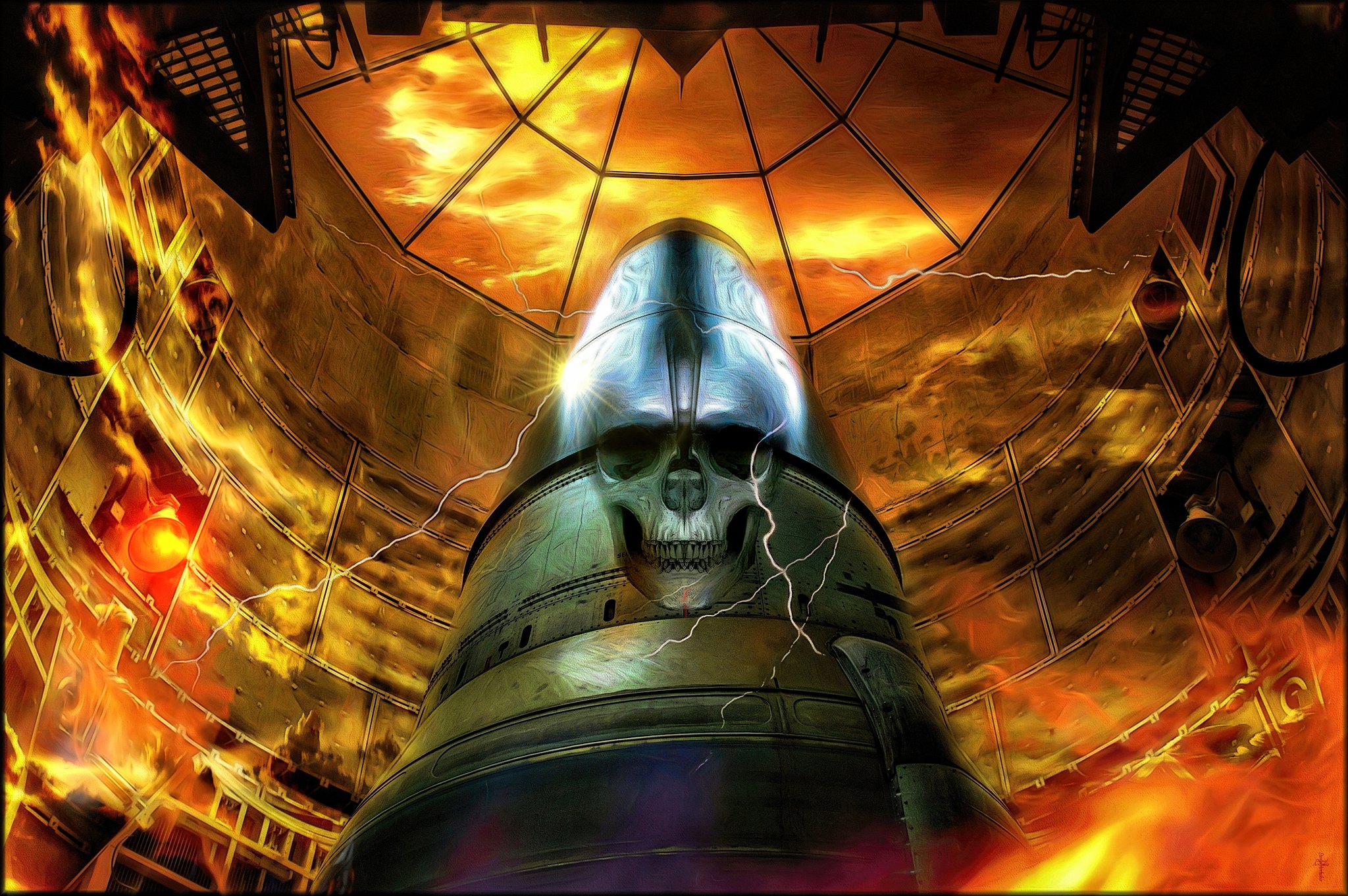The argument over ICBMs shows how nuclear derangement is normalized by national policymaking, says Norman Solomon. Neither side sees the profound need to eliminate them entirely.

Nuclear Nightmare, Open Your Eyes and Awake. (Daniel Arrhakis, Flickr, CC BY-NC 2.0)
By Norman Solomon
Common Dreams
 Nuclear weapons are at the pinnacle of what Martin Luther King Jr. called “the madness of militarism.” If you’d rather not think about them, that’s understandable. But such a coping strategy has limited value. And those who are making vast profits from preparations for global annihilation are further empowered by our avoidance.
Nuclear weapons are at the pinnacle of what Martin Luther King Jr. called “the madness of militarism.” If you’d rather not think about them, that’s understandable. But such a coping strategy has limited value. And those who are making vast profits from preparations for global annihilation are further empowered by our avoidance.
At the level of national policy, nuclear derangement is so normalized that few give it a second thought. Yet normal does not mean sane. As an epigraph to his brilliant book The Doomsday Machine, Daniel Ellsberg provides a chillingly apt quote from Friedrich Nietzsche:
“Madness in individuals is something rare; but in groups, parties, nations, and epochs, it is the rule.”
Now, some policy technocrats for the USA’s nuclear arsenal and some advocates for arms control are locked in a heated dispute over the future of ICBMs: intercontinental ballistic missiles. It’s an argument between the “national security” establishment — hell-bent on “modernizing” ICBMs — and various nuclear-policy critics, who prefer to keep the current ICBMs in place. Both sides are refusing to acknowledge the profound need to get rid of them entirely.
Elimination of ICBMs would substantially reduce the chances of a worldwide nuclear holocaust. The ICBMs are uniquely vulnerable to effective attack, and thus have no deterrent value. Instead of being a “deterrent,” ICBMs are actually land-based sitting ducks, and for that reason are set up for “launch on warning.”
Support CN’s Winter Fund Drive!
As a result, whether a report of incoming missiles is accurate or a false alarm, the commander in chief would have to quickly decide whether to “use or lose” the ICBMs. “If our sensors indicate that enemy missiles are en route to the United States, the president would have to consider launching ICBMs before the enemy missiles could destroy them; once they are launched, they cannot be recalled,” former Defense Secretary William Perry wrote. “The president would have less than 30 minutes to make that terrible decision.”

William Perry in 2015. (DoD. Glenn Fawcett via Wikimedia Commons)
Experts like Perry are clear as they advocate for scrapping ICBMs. But the ICBM force is a sacred cash cow. And news reports currently feature arguments over exactly how to keep feeding it.
Last week, The Guardian reported that the Pentagon has ordered an external study of options for ICBMs. Trouble is, the two options under consideration —extending the life of the currently deployed Minuteman III missiles or replacing them with a new missile system — do nothing to reduce the escalating dangers of nuclear war, whereas eliminating the nation’s ICBMs would greatly reduce those dangers.
But an enormous ICBM lobbying apparatus remains in high gear, with huge corporate profits at stake. Northrop Grumman has landed a $13.3 billion contract to proceed with developing a new ICBM system, misleadingly named the Ground Based Strategic Deterrent. It’s all in sync with automatic political devotion to ICBMs in Congress and the executive branch.
The sea-based and air-based portions of the “nuclear triad” (submarines and bombers) are invulnerable to successful attack — unlike ICBMs, which are completely vulnerable. The subs and bombers, able to destroy any and all targeted countries many times over, provide vastly more “deterrent” than anyone could ever reasonably want.
“ICBMs have only one foreseeable function — to be a ‘sponge’ to absorb the start of a nuclear war.”
In sharp contrast, ICBMs are the opposite of a deterrent. In effect, they’re prime targets for a nuclear first strike because of their vulnerability, and for the same reason would have no “deterrent” capacity to retaliate. ICBMs have only one foreseeable function — to be a “sponge” to absorb the start of a nuclear war.
Armed and on hair-trigger alert, the country’s 400 ICBMs are deeply entrenched — not only in underground silos scattered across five states, but also in the mindsets of the U.S. political establishment.
If the goal is to get big campaign contributions from military contractors, fuel the humongous profits of the military-industrial complex, and stay in sync with the outlooks that dominate corporate media, those mindsets are logical. If the goal is to prevent nuclear war, the mindsets are unhinged.
As Ellsberg and I wrote in an article for The Nation this fall,
“Getting trapped in an argument about the cheapest way to keep ICBMs operational in their silos is ultimately no-win. The history of nuclear weapons in this country tells us that people will spare no expense if they believe that spending the money will really make them and their loved ones safer — we must show them that ICBMs actually do the opposite.”
Even if Russia and China didn’t reciprocate at all, the result of U.S. closure of all its ICBMs would be to greatly reduce the chances of nuclear war.
On Capitol Hill, such realities are hazy and beside the point compared to straight-ahead tunnel vision and momentum of conventional wisdom. For members of Congress, routinely voting to appropriate billions of dollars for nuclear weaponry seems natural. Challenging rote assumptions about ICBMs will be essential to disrupt the march toward nuclear apocalypse.
Norman Solomon is co-founder and national coordinator of RootsAction.org. His books include War Made Easy: How Presidents and Pundits Keep Spinning Us to Death (2006) and Made Love, Got War: Close Encounters with America’s Warfare State (2007).
This article is from Common Dreams.
The views expressed are solely those of the author and may or may not reflect those of Consortium News.
Help Us Cover the Assange Case!
Support CN’s
Winter Fund Drive!
Donate securely with PayPal
Or securely by credit card or check by clicking the red button:


While former SecDef William J. Perry’s efforts to abolish ICBMs and eliminate nuclear weapons in the past fifteen years or so are certainly commendable, it is also worth remembering his role in covertly helping advance the proliferation activities that would keep assorted policymakers, pundits, and civilians clamoring for a continuation of the arms race in the immediate aftermath of the Cold War and prior to the post-9/11 Global War on Terror.
Also bear in mind that these dodgy activities seemingly being sanctioned at official levels occurred at the same time that Wen Ho Lee was having the book thrown at him over unfounded espionage allegations, and happened at the collateral expense of Able Danger, a related data-mining program that in all probability could have prevented 9/11:
“A report commissioned in mid-1999 by Rep. Curt Weldon (R-PA) looks into possible Chinese front companies in the US seeking technology for the Chinese military. Dr. Eileen Preisser and Michael Maloof are commissioned to make the report. Dr. Preisser, who runs the Information Dominance Center at the US Army’s Land Information Warfare Activity (LIWA) and will later become closely tied to Able Danger, uses LIWA’s data mining capabilities to search unclassified information. According to Maloof, their results show Chinese front companies in the US posing as US corporations that acquire technology from US defense contractors. When the study is completed in November 1999, the General Counsel’s office in the Office of the Defense Secretary orders the study destroyed. Weldon complains about this to Army Chief of Staff Eric Shinseki, and apparently delays the destruction of the report. Weldon also writes a letter to FBI Director Louis Freeh requesting an espionage investigation into these Chinese links, but Freeh never responds to this. [WASHINGTON TIMES, 10/9/2005] As part of this report, LIWA analysts had produced a chart of Chinese strategic and business connections in the US. But this data mining effort runs into controversy when the chart apparently shows connections between future National Security Adviser Condoleezza Rice, former Defense Secretary William Perry, and other prominent US figures, and business deals benefiting the Chinese military. [NEW YORK POST, 8/27/2005; WASHINGTON TIMES, 9/22/2005] The China chart was put together by private contractor James D. Smith, who will come forward in August 2005 to corroborate revelations about the Able Danger unit and its findings (see August 22-September 1, 2005). The New York Post later says there is ‘no suggestion that Rice or any of the others had done anything wrong.’ [NEW YORK POST, 8/27/2005] However, articles first appear one month later and through 2001 in the conservative publications WorldNetDaily and NewsMax, which connect Perry and Rice to Hua Di, a Chinese missile scientist and possible spy, and question the nature of their relationship with him. [WORLDNETDAILY, 12/21/1999; WORLDNETDAILY, 4/5/2000; NEWSMAX, 1/24/2001] Di defected to the US in 1989 and worked most of the 1990s at Stanford University’s Center for International Security and Arms Control, which was co-directed by Perry. Di later returned to China and is subsequently sentenced to ten years in prison for writing influential articles said to reveal vital Chinese state secrets. [STANFORD REPORT, 2/7/2001] However, other accounts claim that he was in fact passing on disinformation through these articles, successfully misleading the US military for a couple of years about the abilities of certain Chinese missile programs. [WORLDNETDAILY, 12/21/1999] Additionally, Hua Di teamed in 1994 with Stanford professor Dr. John Lewis and William Perry to buy an advanced AT&T fiber-optic communications system for ‘civilian’ use inside China that instead is used by the Chinese army [and also allegedly served as the basis for the “Tiger Song” air defense network developed by Saddam Hussein’s Iraq]. The General Accounting Office later criticized the sale. In 1997, Stanford University investigated Dr. Lewis for his role in it, but Condoleezza Rice, serving as a Stanford provost at the time, apparently stopped the investigation. [WORLDNETDAILY, 4/5/2000; NEWSMAX, 1/24/2001] Able Danger and LIWA’s data mining efforts will be severely proscribed in April 2000 as part of the fallout from this China controversy (see April 2000), and the destruction of their collected data will follow shortly thereafter (see May-June 2000).”
(Source: History Commons)
In the coming age of hypersonic missiles and extended range air defenses, I do not believe that ICBMs or SLBMs could be of much deterance because of their ballistic natures. that exposes them not just as sitting ducks but also as soaring eagles once air-borne. They may be picked out by space-based hypersonic missiles long before reaching into their intended target areas especially with the help of surface-based humints and sigints. Anyway what is the use of relocating such vulnerable ICBMs in the tri-border area in the heart of Eurasia ? But given your suggested location of Kazakhstan and the earlier arms control activities of William Perry I can’t help but doubt the real motive of such a move, surely it would not be structured for an offensive purpose. I hope I am not wrong in this !
I turned 7 at the height of the Cuban Missile Crisis and that event has influenced my entire life. Us children knew what was at stake (what we would now call the biosphere itself) while the adults pretended everything was okay.
We literally had neighbors who had a bomb shelter, in the now-pricey enclave of Medina (aka Bill Gates’ – land).
Anyone who is serious about how our psyches have been altered by the ‘Sword of Damocles’ referred to by JFK is
encouraged to read the excellent book “By the Bomb’s Early Light”, thoroughly and compellingly researched by
eminent historian Paul Boyer. In the Forward, he describes being in class on October 25th of the crisis, completely unable to concentrate on the lecture, all his energy focused on the clock as it ticked inexorably towards the noon
‘deadline’ hour.
The most compelling part of the book is the collection of essays penned in the late 1940’s, by prescient writers who realized, by the bomb’s early light, that our world had changed radically and would be different going forward.
The scariest part of the book is when Boyer, again presciently, argued that the most dangerous period of the nuclear era was not the Cuban Missile Crises, or the ‘Star Wars’ era. Rather, he said, it would be the early 21st century, when we had become habituated to the presence of nuclear weapons and most of those with the visceral experience of the early nuclear years had passed on. Combine that with aging weapons systems, casual discussion of the use of ‘tactical’ level nuclear weapons, terrorism, tribalism and increased competition for resources, and
there you have a potent recipe for disaster.
One possibility Boyer did not consider is that of one (or more) space rocks impacting sensitive areas at a time of high tensions, which could be confused with a nuclear attack. The Tunguska Event of 1908 would have taken out the city of St. Petersburg if it had occurred 3 hours later. The 2013 Chelyabinsk meteor narrowly missed a large Air Base on the outskirts of the city. In the confusion of the moment, how would we respond if a space rock vaporized Washington DC ? (Not all space rocks are visible in advance, particularly if they are coming from the direction of the sun, where our sensors do not function).
“By the Bomb’s Early Light” is highly recommended reading, affordably available through used book services.
Sorry to misinterpret the article. The topic is not ICMB as such but
-

Piotr Berman
December 17, 2021 at 11:07
-

Piotr Berman
December 16, 2021 at 22:49
It makes perfect sense for USA to abandon ICBM program, given better quality deterrent. “Nuclear Triad” has a long tradition, and “Triad” sound much better than humble “pair”, but skipping “land component” of the triad would not decrease the deterrence in any meaningful way. Pentagon has specialized services to produce adequately nice sounds without using sonorous “triad”, e.g.
After checking the link to the orchestra of US Air Force, of four links in “Videos” only one is working. Compare it with Russian military music on YouTube. This is perhaps a facetious example, but overspending on unnecessary programs starves other programs that could of much help with very little extra resources.
ICBM can be an effective deterrent. One way is to (a) place the launching sites in the center of a continent (preferably, Eurasia, close to the joint border of Russia, China and Kazakhstan), (b) make a lot of decoy launching sites and perform shell game. Part (b) is expensive, and may be contrary to the current treaties.
If the opponent persists to develop “first strike capabilities”, that necessitates to put the deterrent force on “hair trigger” and enable “dead hand’s revenge”. That maintains the deterrence, but it is also utterly mad. However, to is the American pursuit of first strike capabilities — coupled by missile defense systems — that starts the madness.
Nuclear submarines may be superior as a deterrent, but alone, they give the advantage to USA.
There are benefits of deterrence — while MAD has elements of madness, avoiding WWIII may be worth it. However, nuclear arms race is insane, if one side will gain advantage, the other side can engage in hiding games and hair trigger posture, so it is not realistic to gain a DECISIVE advantage, and in no side gains advantage, the entire effort is futile. Neither outcome is desirable.